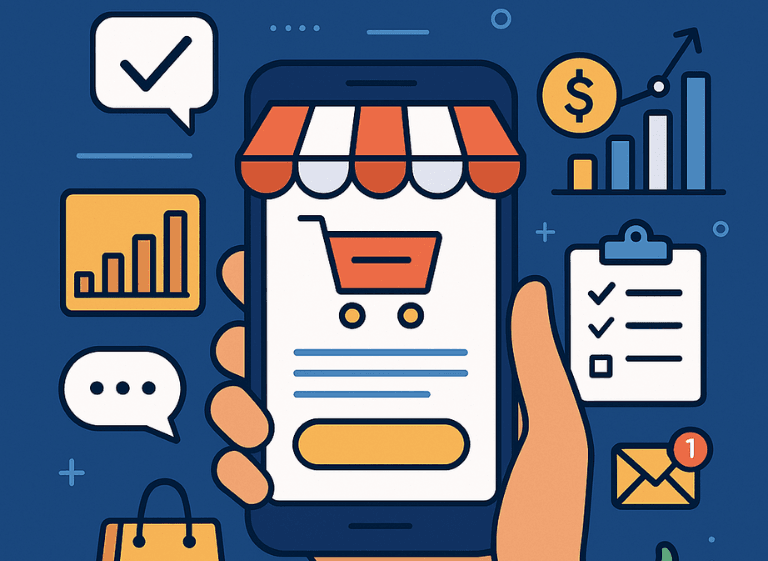Mobile app development
E-Commerce Solutions
Data analytics
CMS integration
How to Manage Your Online Store from Mobile Devices
Iliya Timohin
2025-04-07
Managing an online store no longer means being tied to a desktop. As mobile traffic continues to dominate e-commerce — with over 70% of shoppers browsing and buying via smartphones — store owners are shifting toward mobile-first management. Whether it’s checking orders on the go, tracking stock during travel, or engaging with customers in real time, mobile tools allow you to stay in control anytime, anywhere.

Sound familiar? You’re in a meeting, on the road, or simply taking a break — and suddenly, order notifications pile up, a customer needs help, or stock hits a critical low. Without mobile access, you're forced to delay, miss opportunities, or lose sales. This is where mobile e-commerce management steps in — turning your phone into a full-function control panel.
In this article, we’ll explore how to simplify store operations using mobile solutions and which tools are best for running your e-commerce business from your phone.
How Mobile Tools Streamline E-Commerce Operations
Mobile e-commerce management tools help business owners run their stores from anywhere, with instant access to core features and data. These solutions eliminate common bottlenecks in online retail — from delayed responses to inventory issues — by keeping essential functions always within reach. Whether you're tracking orders during your commute or restocking while on the move, mobile access speeds up decisions and strengthens responsiveness.
For example, shopping applications have already transformed how consumers browse and buy — store management must evolve just as quickly to stay competitive.
Essential Mobile Tools for Managing an Online Store
Mobile Admin Panels for Real-Time Control & Customer Support
Mobile admin panels let store owners monitor their e-commerce business directly from a smartphone. With tools like Mobile Admin PRO for CS-Cart and OpenCart, you can process orders, update products, and answer customer queries without opening a laptop. It’s a must-have solution for busy sellers who need to stay connected around the clock.
Mobile Dashboards That Boost Store Efficiency
Mobile dashboards visualize your performance in real time: total revenue, order volume, conversion rates, and more. For small and growing businesses, this immediate overview is critical. It helps you spot issues — like inventory drops or sales slowdowns — and address them before they escalate. These are real-time store management solutions for small businesses that prioritize speed and data clarity.
Best Practices for Mobile Sales, Inventory, and Customer Monitoring
To make the most of your mobile tools, follow these proven habits:
- Enable push alerts for new orders and low stock notifications to act fast
- Check your dashboard daily to spot trends and monitor KPIs
- Reply to customer messages directly via mobile to increase satisfaction
- Segment customer data on the go and send tailored follow-ups
These actions make your workflow leaner and customer communication sharper.
Advanced Mobile E-Commerce Analytics for Data-Driven Growth
How Real-Time Analytics Improve Business Decisions
Modern analytics tools allow you to track user behavior and campaign results without delay. With solutions like Enhanced eCommerce for GA4, you gain immediate access to traffic sources, product performance, and checkout behavior — all from your phone. No need to wait for end-of-week reports.
Key Metrics Every Store Owner Should Track from Mobile
Focus on the following mobile-accessible metrics to drive results
- Conversion rate — measures how well visitors are turning into buyers
- Customer acquisition cost (CAC) — shows your ad efficiency
- Cart abandonment rate — indicates friction in checkout
- Revenue per user — a benchmark for profitability
Monitoring these data points via mobile helps you tweak marketing, pricing, and UX in real time.
Mobile Inventory Management Tools for E-Commerce Sellers
Why Mobile Inventory Tracking Is Crucial for Fast-Growing Stores
Inventory problems can break trust and reduce sales. With mobile tracking, store owners can act immediately when stock runs low, avoid over-ordering, and streamline logistics. Whether you're selling fashion items or electronics, a mobile inventory system helps you stay agile — especially when managing multiple SKUs.
How to Sync Inventory Across Multiple Sales Channels
Using integrated tools like Mobile Admin PRO, you can sync stock between platforms like Shopify, CS-Cart, OpenCart, and PrestaShop. This ensures real-time accuracy across marketplaces and prevents overselling — a must for multichannel growth.
How Mobile Tools Improve Customer Engagement & Retention
Push Notifications for E-Commerce Communication
Push notifications are powerful tools for real-time engagement. From cart recovery reminders to flash sale alerts, they give your store a voice on the customer's screen — instantly. These are essential in any modern customer engagement strategy for e-commerce.
How Alerts Drive Satisfaction and Retention
Timely updates build trust. Customers appreciate being informed about shipping, discounts, or order changes — and they’re more likely to return when your communication is proactive and helpful.
Best Practices to Avoid Notification Fatigue
To maximize engagement without annoyance:
- Send no more than 1–2 push messages per day
- Personalize alerts using behavior-based triggers
- Let users choose what types of notifications they receive
Social Media Integration to Boost Mobile Shopping Engagement
Why Social Media Connectivity Matters in Mobile Commerce
Buyers expect a seamless flow between browsing, shopping, and sharing. With Social Media Login modules, you make it easy for users to register and log in via Facebook, Google, or Apple. This not only simplifies access but also encourages more social sharing and user-generated content.
Examples of Brands Using Social to Drive Engagement
Well-known brands like Nike and Starbucks integrate mobile shopping with social platforms. Their apps allow customers to post purchases, earn rewards, and share experiences — all of which deepen loyalty. Even small businesses can benefit from this model by encouraging reviews, reposts, and product tagging.
How Mobile Admin Tools Help E-Commerce Businesses Scale
Case 1: How a Niche Skincare Brand Improved Efficiency with Mobile Store Management
A hypothetical example
A small skincare brand adopted a mobile-first workflow using Mobile Admin PRO. By handling customer service and order processing via smartphone, they significantly reduced response delays (by an estimated 40%) and increased upsell rates thanks to more responsive communication.
Case 2: Using Real-Time Analytics to Optimize Advertising Performance
Based on a typical use case
An electronics retailer tracked ad campaign data using Enhanced eCommerce for GA4. When a regional ad set showed low conversions, they paused it and redirected the budget to better-performing regions — resulting in an estimated 20–25% uplift in weekly revenue due to better ad targeting.

The Future of Mobile E-Commerce Management
Why Mobile Store Management Will Keep Evolving
As mobile commerce becomes the default, e-commerce store owners need flexible, responsive tools to stay competitive. Those who adopt mobile-first management gain a clear edge — from real-time data access to stronger customer relationships and faster decision-making.
Why Mobile Store Management Will Keep Evolving
Expect to see mobile tools that leverage AI to tailor customer journeys, forecast demand, and adjust pricing dynamically. These innovations will shape how stores operate and scale.
Why Go Mobile? Here’s What You Gain
Mobile-first management means:
- Freedom: Run your store from anywhere, anytime
- Speed: React instantly to orders, issues, and trends
- Control: Monitor analytics, stock, and support in real time
- Engagement: Stay close to your customers with smart notifications
- Scalability: Grow across platforms with synced tools and data
If you’re looking to simplify, optimize, and grow your e-commerce business — mobile-first management is no longer optional, it’s essential.